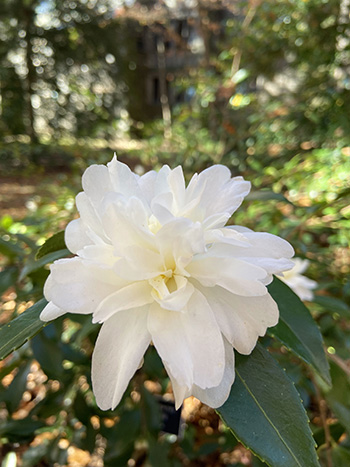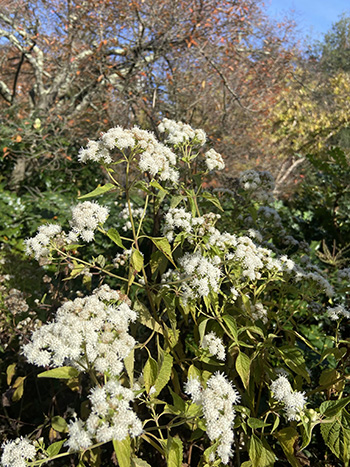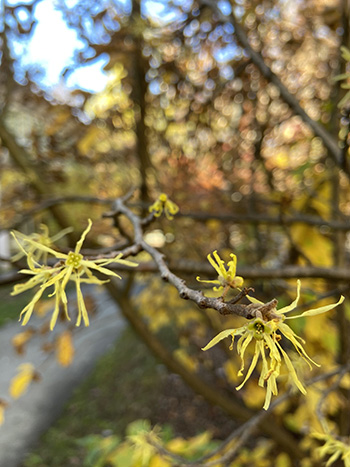
Plants of the Week: Nov. 7

Camellia ‘Snow Flurry’ (camellia)
The fall-blooming camellia season is upon us! During this time of thoughtful beauty it seemed appropriate to revisit the origin story for many of the specimens currently in bloom. The Winter Series, or Ackerman Hybrids is a collection of cold hardy camellias that were born out of disaster at the U.S. National Arboretum. A series of cold winters had nearly destroyed the collections of camellia species and varieties; of the 956 specimens, only 15 had survived. Prevailing through the successive harshness of winter’s icy touch was the C. oleifera. Dr. William Ackerman, a plant hybridizer at the arboretum made interspecific crosses between C. oleifera and C. sasanqua, C. hiemalis, and C. vernalis selections. The resulting hybrids, released in 1991, were praised as showing little to no winter injury as far north as Zone 6. The Ackerman Hybrids are all fall-blooming and one of the earliest to show its fanciful blooms is the Camellia ‘Snow Flurry’.
Located in the Camellia Collection along College Ave here at Scott Arboretum, this specimen is a cross between Camellia ‘Frost Princess’ (flower form) and Camellia oleifera ‘Plain Jane’ (cold hardiness). Each white flower is 3-4 inches wide and consists of twelve petals surrounding a prominent center of petaloids (small petals) and golden stamens.
Like most camellias, this plant needs consistently moist, well-drained soil with high organic matter and thrives in partial shade and sheltered spaces. The Scott Arboretum recommends installing camellias in the spring so they have plenty of time to establish roots before winter sets in.
It is a wonderful time to enjoy our camellias at the Scott Arboretum, not only to take in the beauty of the evergreen shrubs and their blooms but also to appreciate the history, perseverance, and adapted survival of this plant genus! Photo credit: M. Rossman

Ageratina altissima (white snakeroot)
We minded our business and tended to our gardens all summer long: removing weeds, trimming plants back, adding mulch. We thought we knew every plant in our garden beds and had them just the way we wanted. But we were wrong. Because growing inconspicuously in shady spots and between our garden plants was a one- to four-foot tall plant with toothy, dark green leaves. It hid perfectly in plain sight and then POOF! It’s everywhere you turn, all adorned with fluffy white flowers.
Ageratina altissima formerly known as Eupatorium rugosum, is one of the latest U.S. eastern natives to bloom. And while its lovely clouds of white blooms may sway you to keep it, beware – it has a dark history and an aggressive future.
White snakeroot got its name because early settlers believed it could be utilized to treat snakebites, when in reality it is quite toxic. Containing the toxin trematol, humans that consume products from cows who have grazed on Ageratina altissima develop milk sickness, a potentially life threatening condition. And while this is no longer a concern for us dairy and meat eaters, white snakeroot can still present problems.
Known to be particularly aggressive, it can spread by seeds or rhizomes. Additionally there is a popular variety, ‘Chocolate’, introduced by Mt. Cuba Center that has attractive purple stems bearing dark chocolate-brown tinged leaves. And while it may look pretty for a season it will quickly revert back to its green origins. In many areas of the Scott Arboretum we try to deadhead the flowers before seeding or remove the plant all together due to its aggressive nature. However, being one of the last wild natives to flower, it is a godsend to hungry insects like bees, moths, and flies as winter quickly approaches. So while we must champion natives, I will leave this plant to the discretion of the individual gardener and how they choose to navigate their own path with the tricky white snakeroot. Photo credit: M. Rossman

Hamamelis virginiana (common witchhazel)
The witchhazels have started to bloom! Behind the Science Center on Whittier Place there is a collection of Hamamelis virginiana that have started to show their stem-hugging clusters of bright ribbon-shaped yellow flowers.
Blooming October through December, this small eastern native tree can be found naturally in woodlands, forest margins, and stream banks. It grows in Zones 3-8 and has lettuce-green deciduous leaves that turn brilliant gold in fall. Petals appear after the leaves have dropped and fertilized flowers will form fruit throughout the winter. Upon drying during the spring, the seed capsule will then eject its 1-2 small seeds as far as 30 feet. The common witchhazel is extra neat because this is the only tree in North America to have flowers, fruit, and next year’s leaf buds all at once!
While the Hamamelis virginiana gets a lot of press these days for its use in skincare products, it has been a useful species for quite some time. The common name comes from the folk practice of “water-witching,” where early settlers would carry a forked or bent witchhazel branch as a divining rod. They would observe whether the branch twisted or dripped, which they believed signaled underground water sources.
Here at the Scott Arboretum we have much to anticipate in the way of witchhazels, but it is certainly exciting to see the beginning of the Hamamelis blooming season starting behind the Science Center. Photo credit: M. Rossman





No Comments